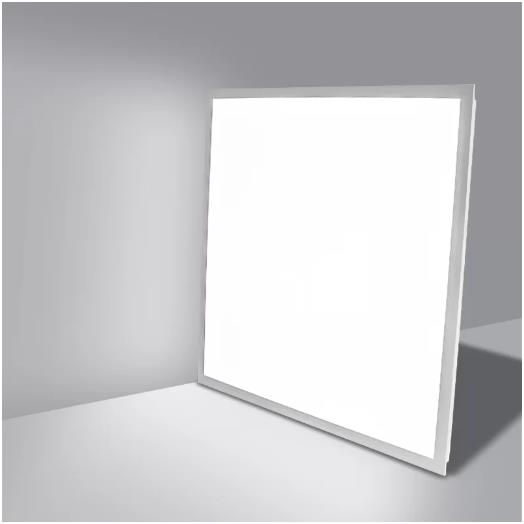Detailed explanation of key technologies of LED panel lights
With the development of the LED lighting industry, LED panel lights, derived from LED backlights, have uniform light, no glare, and exquisite structure, which have been loved by many people and are a new trend in modern and fashionable indoor lighting. Today, the LED panel light manufacturer Xinjielighting will unlock the three key technologies of LED panel lights for everyone.
LED panel lighting performance (light distribution):
The optical performance of LED panel lights mainly involves the performance requirements of luminosity, spectrum and chromaticity. According to the latest industry standard "Semiconductor Light Emitting Diode Test Method", there are mainly luminous peak wavelength, spectral radiation bandwidth, axial luminous intensity angle, luminous flux, radiant flux, luminous efficiency, chromaticity coordinates, correlated color temperature, color purity and dominant wavelength, parameters such as color rendering index. For white LEDs commonly used in LED panel lights, color temperature, color rendering index and illuminance are particularly important. They are important indicators of lighting atmosphere and effects, while color purity and dominant wavelength are generally not required.
The mainstream practice in the LED industry is to perform light distribution when making LED panel light fixtures after packaging LED chips to form a light source or a light source module. glow. If you want to guide the light to the application side, Philips' traditional LED panel light is the best one, and the light loss also reaches 40%. However, the optical parameters of lamps applied by many downstream manufacturers of LED panel lights in China are actually the optical parameters of chips or light sources, not the optical parameters of the overall LED panel lights.

How to better improve the performance of light, the latest technology in the world is to do light distribution on the LED panel light chip package, export the light of the LED panel light chip at one time, and maintain the maximum light output, so that the LED panel light loss rate is only 5% -10%. With the continuous improvement of technology, the light loss rate of LED panels will be lower and lower, and the light efficiency of the light source will be higher and higher. Also equipped with such a light source LED panel light does not need to do light distribution, the relative efficiency of the lamp will be greatly improved, making it more widely used in functional lighting, forming a market channel of considerable scale. Therefore, a good LED panel light supplier is our top priority. We don't need to spend a lot of money to study how our LEDs are distributed, and we don't need to spend a lot of time and experience for engineers to use software simulation. The simplest The method is to let LED white light suppliers cooperate. You know, if our engineers use software to simulate, the necessary actions are input and output. The input is the import of data in the early stage, and the output is the result of the simulation, so the data in the early stage must be accurate and the back-end simulation can be correct.
LED panel light thermal performance (structure):
The supply of LED luminous efficiency and power of LED panel lights for lighting is one of the keys to the LED industry. At the same time, the PN junction temperature of LEDs and the heat dissipation of the housing are particularly important. The greater the difference between the PN junction temperature and the lamp body temperature, the greater the thermal resistance, and then the light energy is converted into heat energy and consumed in vain, and the LED is damaged in severe cases. A good structural engineer should not only consider the structure of the lamp and the thermal resistance of the LED, but also consider whether the shape of the lamp is reasonable, fashionable and novel, and of course reliability, maintainability and practicability. Think from the perspective of LED panel light, and consider the product from the perspective of LED panel light users.
Today's common technology is to use aluminum substrates for packaging. There are core technical bottlenecks in the heat dissipation and light conversion efficiency of aluminum substrate packaging. It cannot effectively control the junction temperature and stably maintain the high-power light output of LED panel lights, and the application will be due to LED panels. The higher the light efficiency of the lamp chip, the larger the required area of the aluminum substrate, which will increase the cost and application volume, which is extremely inconvenient. So how to get out of this misunderstanding and find a new way is the core feature of the new technology. On the premise of maintaining low cost and passive heat dissipation, the use of high thermal conductivity medium, through the new overall structure of the device/lamp, reduces thermal resistance, lowers the PN junction temperature, makes the PN junction work within the allowable operating temperature, and maintains the maximum number of photons Output, the minimum requirements are as follows:
(1) Ultra-low thermal resistance material, rapid heat dissipation overall structure technology;
(2) High thermal conductivity and anti-UV packaging technology;
(3) Application of low environmental stress structural technology;
(4) Overall thermal resistance <20K/W, junction temperature <80 degrees;
(5) The working temperature of the LED panel light lighting module is controlled below 65°C.
LED panel light electrical properties (electronics):
If a lighting fixture LED panel light is compared to a girl, then light distribution is her connotation, structure is her appearance, and electronics are her heart. (It's always the beautiful, stylish beauties that attract people's attention, and so are the products). A good LED panel light can determine its lifespan. The current trend and update of LED panel light technology is changing with each passing day, and engineers have to spend a lot of energy to learn, absorb, decompose and apply new technologies. The pre-planning, mid-term implementation of lamp design, and the entire process of forming in the later stage need to form documents and data, which is also the most tedious thing in the design.
Well, the above is the whole content of the key technologies of LED panel lights brought to you by xinjielighting. In short, the key technologies of LED panel lights mainly include three points: optical performance, thermal performance and electrical performance. I hope the above content is helpful to you. For more information on led panel lights, please refer to the following:
What are the components of LED panel lights?
How to distinguish good and bad LED bulbs?







